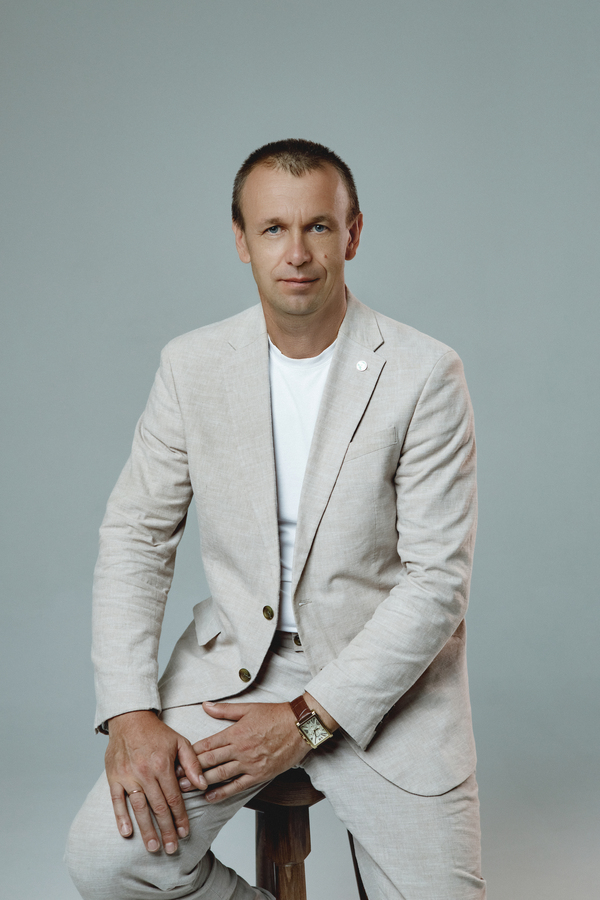
I am the rector of Sumy National Agrarian University, Ihor Kovalenko. Thirty years ago, I joined the university family of SNAU, studied at the bachelor’s, master’s, and postgraduate levels. I received the academic title of professor and the degree of Doctor of Biological Sciences.
During this time, I realized the main thing – the university should constantly be aimed at developing and improving every aspect of the educational and scientific processes. For almost half a century of its existence, the university has gone from the Sumy branch of the Kharkiv Dokuchaev Agricultural Institute to a powerful educational and scientific complex of national importance. And today we need even more efforts to remain a leading university in a complex border region.
Our priorities are:
Security on the campus. The university already has 8 certified simple shelters with almost 2000 seats. In 2023, one of them was overhauled, expanding its capacity, and in 2024, 3 modern classrooms were equipped for the national multi-subject test, unified entrance exams, and unified professional entrance test.
Searching for and attracting sources of extra-budgetary, grant funding and business to improve the quality of educational services, living conditions for students, and infrastructure changes. Students can participate in various projects and grants from Erasmus+, DAAD, and other international partners.
Creating a memory gallery for graduates who gave their lives for Ukraine’s independence.
Updating the material and technical base and online platforms
This is only a small part of the steps we are striving to take. The university is developing, adapting to the realities and implementing a modern, safe and effective approach to training specialists who build the agricultural sector and society as a whole.
Sincerely, Ihor Kovalenko,
Rector of Sumy NAU,
Doctor of Biological Sciences,
professor
Sumy National Agrarian University is a higher educational establishment with level – IV of accreditation; it is one of the best agrarian universities of Ukraine. Sumy National Agrarian University was founded in 1977; for 40 years of its existence, it has gone from Sumy branch of Kharkiv Agricultural Institute named after V.V. Dokuchaiev to powerful educational establishment of national importance.
Sumy National Agrarian University trains highly qualified specialists for agriculture with profound learning of foreign languages and computer science. The structure of University includes 8 faculties, one Institute and five colleges.
Nowadays large agricultural joint-stock companies and processing enterprises of Ukraine need highly-qualified specialists, capable to work on the new technologies. Students of Sumy National Agrarian University get theoretical knowledge and use it in practice at leading agricultural enterprises of Ukraine and foreign countries our University cooperates with.
Our students have the unique opportunity to go abroad and to work on the agricultural farms in England, Denmark, Finland, Sweden, France, the USA, Australia, the Netherlands; it greatly increases their professional level and helps them to be employed at leading agricultural and processing enterprises of Ukraine.
There are about 11,000 students at the university. At the University there is a conception of unremitting computerization: we have 1,000 computer seats and the amount of contact display time spent by each student, depending on his or her specialty, is 250-350 hours. Students and teachers have the opportunity to get information about new achievements of science through international information network Internet. There is a local computer network at the University.
Scientific and research work is conducted in 19 research laboratories; we have 26 specialties for postgraduate students. Research Institute of Potato-breeding in the north-eastern region of Ukraine was founded at the Department of plant-breeding and seed-production.
In the library of Sumy National Agrarian University there are more than 500,000 editions: scientific, educational, fiction, additional publications, e-books for distance learning with access to the Internet.
We have an educational and scientific laboratory (vivarium) for practical training of students, where farm animals and poultry are kept, it is like a living textbook for future veterinarians, livestock experts and specialists of other faculties of Sumy NAU; an educational and experimental farm situated on the territory of 2, 6 thousand ha, agricultural lands include 2, 3 thousand ha; experimental field, where engineers-technologists work using machines for crop cultivation on new technologies.
The university campus is the pearl and the glory of Sumy. Educational buildings, stadiums, laboratories, hostels are located on large, clean and well-equipped territory. The University has a cafe and a canteen with the lowest prices in the town, a club and gyms, where about 3,000 students go in for sport in 20 sport sections.
In the youth-entertainment center there are different clubs, art studios, amateur groups. Every year we hold a contest among the first-year students “Meet: here we are!” Amateur groups are groups with rich creative history, repertoire, own traditions.
Self-governing, which is closely connected with organizational and management activity of students, takes active part in the formation of a future specialist. Nowadays bodies of student government are organized at every faculty and in hostels; student university administration has been working.
Sumy National Agrarian University has become a real “source of manpower” for many agricultural enterprises and institutions of Sumy region and Ukraine. The University is proud of its graduates. Some of them conduct research work, teach students, but most of them work successfully in the agricultural sector of our country.
Rector of the university Volodymyr Ivanovych Ladyka, Doctor of Agricultural Sciences, Professor, Academician of the National Academy of Agrarian Sciences of Ukraine, is also a graduate of Sumy National Agrarian University. In his work he keeps the best university achievements and traditions, and constantly moving forward, he tries to find new creative forms of educational process and research activity.

